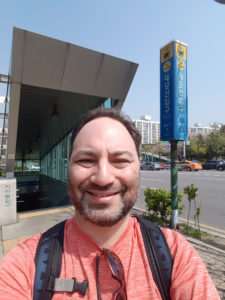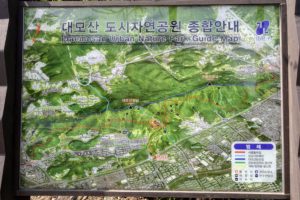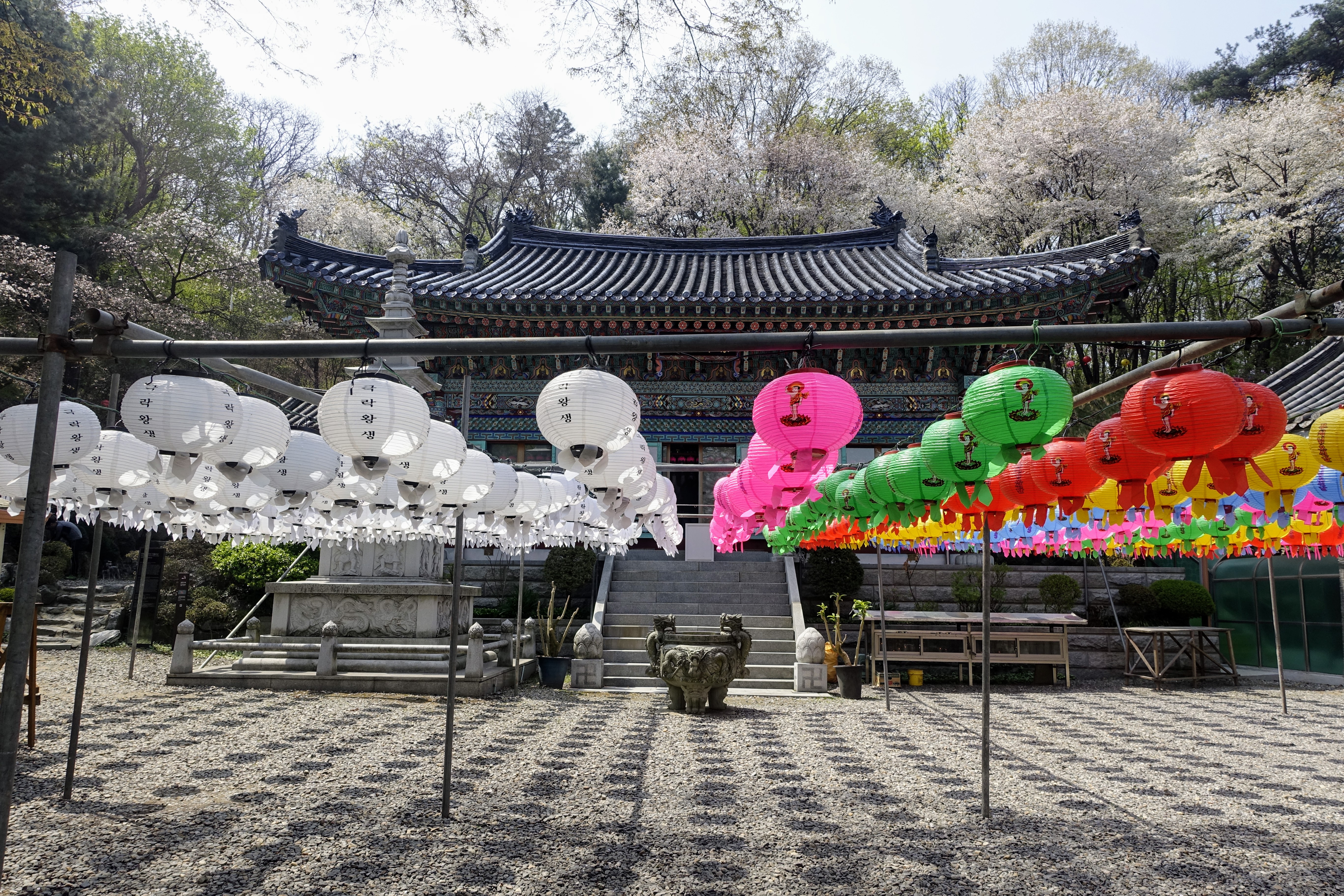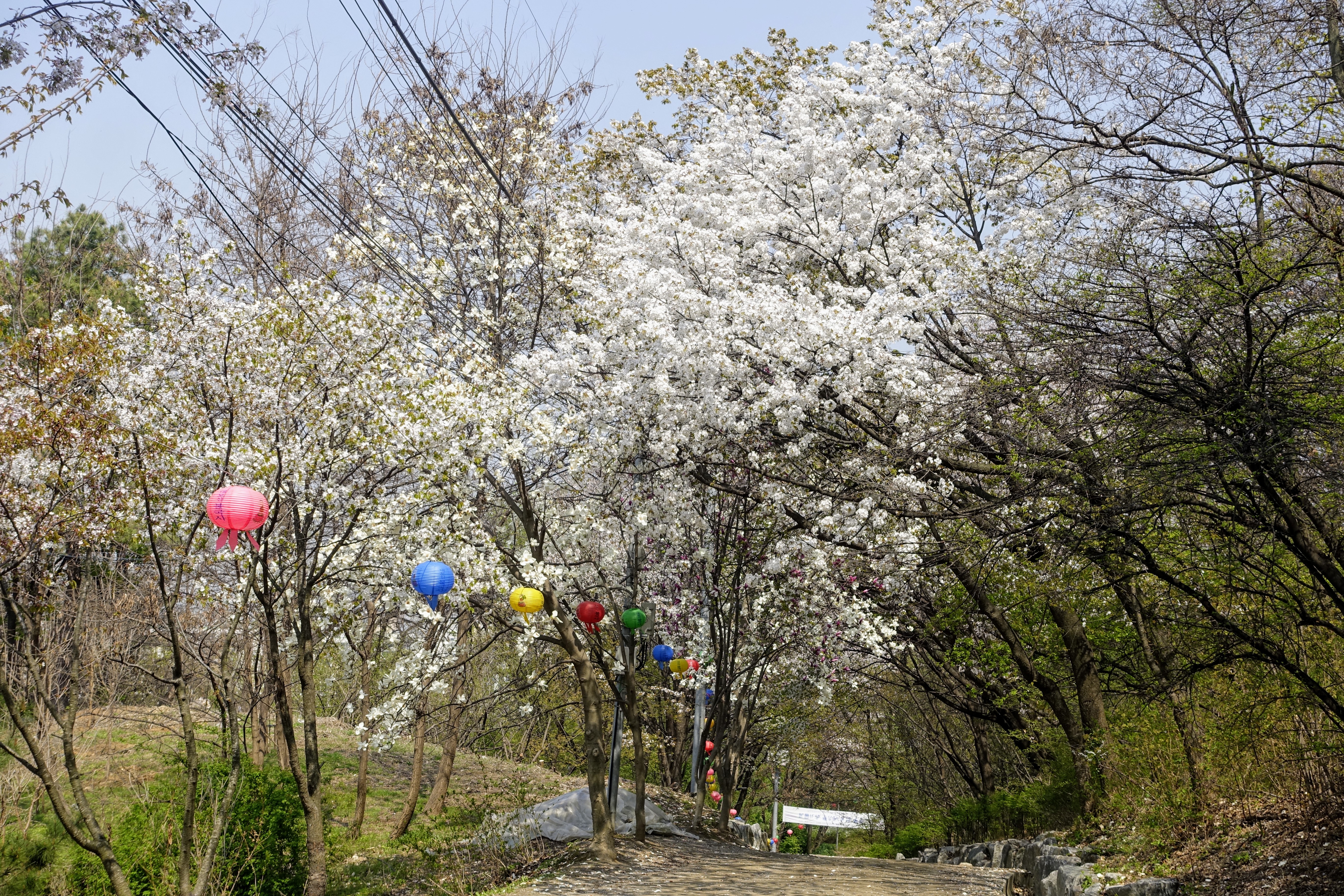- Random subway station:

- Daemosan/대모산역, Bundang Line
- Points of interest:
- Other stations visited:
- Irwon/일원역, Line 3
Whan that aprill with his shoures soote
The droghte of march hath perced to the roote,
And bathed every veyne in swich licour
Of which vertu engendred is the flour;
Whan zephirus eek with his sweete breeth
Inspired hath in every holt and heeth
Tendre croppes, and the yonge sonne
Hath in the ram his halve cours yronne,
And smale foweles maken melodye,
That slepen al the nyght with open ye
(so priketh hem nature in hir corages);
Thanne longen folk to goon on pilgrimages,
And palmeres for to seken straunge strondes,
To ferne halwes, kowthe in sondry londes.
And so it was on this particular April day, in this particular land, full of fresh flowers, tender crops for sale alongside the trails, birds making melody, when I felt the longing to head out into the mountains and found my way to a far hallow occupied by a Goryeo-era Buddha.
Up the mountain

Daemosan is one of Seoul’s lesser mountains, only 300 meters or so and nowhere special, with none of the granite outcroppings that decorate the more impressive massifs. But it’s still a mountain covered in forest, it offers impressive views of Gangnam and Jamsil.
And best of all, it’s relatively uncrowded. Get away from Seoul’s top locations where absolutely everyone goes on a Saturday, and you don’t get solitude exactly — the trails were full of picnicking groups of hikers, mostly clusters of retirees — but you can at least escape the oppressive sense of swimming through a sea of people, which can follow you not just in popular market or nightclub areas, but even on the more popular hiking trails at places like Bukhansan.
We decided to head up to Daemosan Peak. As we entered the woods, we delighted in the fresh leaves of spring and the bright flowers everywhere. Soon the trail opened out onto a wide expanse of cemetery plots overlooking rows of low-slug, depressingly uniform apartment blocks: two different kinds of death facing off.
We edged around this spur of civilization, then began our ascent in earnest. If ever we were unsure of which way to go, we just followed the hikers, assuming that anyone in a mountaineering costume was probably headed to the same place we were.
On one of those steep stairways, we found a small bundle of folded cash. We tried calling ahead to the people up the trail, but no one noticed. Soon we passed a couple of young men who had stopped by the side of the trail and asked if it was theirs. “How much was it?” one of them asked, but his friend laughed and gave him a smack on the shoulder, and they admitted it wasn’t theirs. We left it where we found it, hoping either that its owner would come looking for it, or that it would be picked up by someone who needed it more than us. For all I know, it’s still sitting there waiting. Koreans can be spectacularly corrupt at a macro level, but tend to be surprisingly honest about little things like lost wallets.
Misemeonji
The Korean term for fine-dust pollution is the pungent misemeonji, and the air was full of it, obscuring the views from the top of Daemosan.
It was nice to rise above it for a bit.
Up at the top of the mountain, we took a break to eat our kimbap, and I observed a curious ritual involving half-buried tires. Older Koreans seem to feel that the mountain is the place to go to deal with an aching back — you can sometimes see a halmeoni smacking her back rhythmically against a tree — and the tires are a clever innovation. Basically, you just lie down on one to stretch out your back, and then you wave your arms around in circles. The stretch you get is more substantial than you might expect.
Will the real Bulguksa please stand up
 On our way to Daemosan’s second, slightly higher peak, we saw a sign for Bulguksa temple and veered off to check it out. The temple, and the trails leading down from it, were decorated with lanterns in preparation for the upcoming Buddha’s Birthday holiday.
On our way to Daemosan’s second, slightly higher peak, we saw a sign for Bulguksa temple and veered off to check it out. The temple, and the trails leading down from it, were decorated with lanterns in preparation for the upcoming Buddha’s Birthday holiday.
 Bulguksa is the name of one of Korea’s most famous temples, way down in Gyeongju, but this was obviously not that Bulguksa. Still, it was a very old temple housing a Buddha that supposedly dates back to the late Goryeo Dynasty, some 600 years ago. Like most old things in Korea, it’s been endlessly repaired, so neither the temple nor the statue in its present form date back that far — the Buddha is covered in layers of plaster — but it was still interesting to sit for a while in the presence of something that’s been the focus of devotion for centuries. A side shrine at the temple was devoted to the mountain god, a good example of the way Buddhism has, over the years, provided something of a safe harbor for Korean shamanism.
Bulguksa is the name of one of Korea’s most famous temples, way down in Gyeongju, but this was obviously not that Bulguksa. Still, it was a very old temple housing a Buddha that supposedly dates back to the late Goryeo Dynasty, some 600 years ago. Like most old things in Korea, it’s been endlessly repaired, so neither the temple nor the statue in its present form date back that far — the Buddha is covered in layers of plaster — but it was still interesting to sit for a while in the presence of something that’s been the focus of devotion for centuries. A side shrine at the temple was devoted to the mountain god, a good example of the way Buddhism has, over the years, provided something of a safe harbor for Korean shamanism.
From there, rather than heading back up for the second peak, we decided to call it a day and head back down. The trail descended gently through forests rich with flowers — magnolia, cherry blossoms, baby’s breath and more — before emerging into those rows of low apartment blocks and finishing up at Irwon Station.

Bonus: New York Burger and Bagel
If you live in Seoul and eat food, you should know about A Fat Girl’s Food Guide. For our post-hike dinner, we took her advice on New York Burger and Bagel, on a quiet side street near Gangnam Station.
You know how when you’re looking for a Chinese or an Indian restaurant or whatever, you peek inside to see if there are any actual Chinese or Indian people eating? Well, in Seoul it’s Americans you look for. Not only did New York B&B have a bunch of American patrons, but there was an actual white girl cooking in the kitchen! That’s a rare sight indeed in Seoul. It makes a difference, I think, when the people preparing your food know what it’s supposed to taste like. The owner is a Korean-American who grew up in NYC, and the B&B Special was the best burger I’ve had in Korea — way better than Shake Shack, and without the lines.
Also published on Medium.











